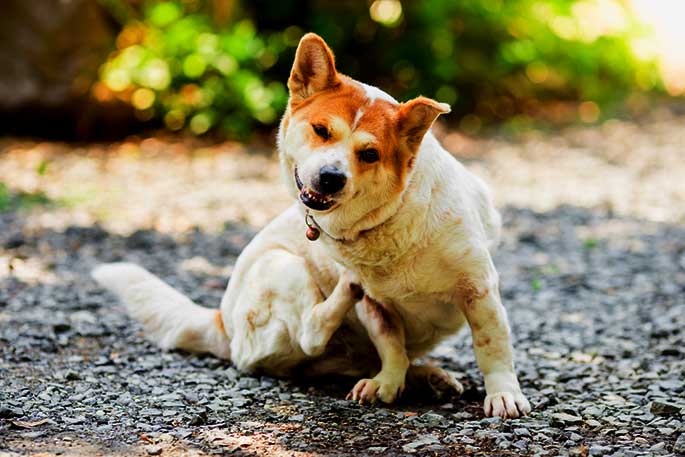
Skin allergies are a common occurrence in dogs. Whether it be dry, flaky skin, insect bites or hair loss, skin ailments can show up any time any place. So, it’s important to know what to do when unexpected trouble spots pop up.
1. Notice the Symptoms
Of course, the first step to treating your dog’s allergies is recognizing the symptoms before they result in a serious issue. There are tons of different allergies ranging from rashes to bald patches, so you need to know what to look for. Scratching, chewing, inflammation and fur loss can all be signs of trouble. And, odds are, they’re symptoms of one of the following common allergies.
Moist Dermatitis, also known as hot spots, comes from insect bites, infections, excessive licking and chewing and a number of other things. However, you can typically spot this condition by the red, inflamed areas on your pup’s head, hips and chest.
Yeast Infections most commonly infect puppies and show up as discoloured, itchy skin that your dog can’t stop scratching. Often, it appears on the ears and paws.
Ringworm is caused by fungus and shows up as round, scaly patches that can break open and cause hair loss. You may find them on your pooch’s head, paws, ears and forelegs.
Mange, also known as canine scabies, can cause bald spots, sores and ugly scabs. Mites make a home out of and infect dogs, which then easily spread the disease to other canines. Treatment depends on the type and severity of mange.
2. Treat With Coconut Oil
Humans have been using coconut oil for years to treat dry skin and even improve their dental health. But coconut oil is also great for treating canine maladies like skin allergies. The oil contains lauric acid— which is antifungal, antibacterial and anti-viral — and capric and caprylic acids, which also prevent and stop fungal growth. Applying coconut oil can even decrease your pooch’s yeast production, acting as a treatment for yeast infections.
You can either feed coconut oil to your dog orally or apply it topically. However, for skin allergies, it’s best to directly apply the oil to your dog’s skin. Apply coconut oil topically to hot spots, dermatitis or other irritated areas and let sit for five minutes. This can help remedy flaking and moisturize your pup’s skin. Wash and rinse if their fur feels excessively oily or simply stick to shampoos with organic coconut oil during bathtime to help soothe their allergies.
3. Create a Healthy Environment
Your pup’s environment plays a huge role in the condition of their skin. For instance, if your home is too dry, your dog may develop flaky skin and dandruff. And, if it’s too damp or humid, the excess moisture in the air can cause hot spots to appear. To prevent these allergies, install a dehumidifier or humidifier depending on your pup’s symptoms and try to maintain a consistent environment for them.
It’s also important to create a clean, safe environment for your dog. Remember, their body and face are nearer to the ground than yours, so they’re more susceptible to allergies from dust, plants and pollen. When you talk your pooch for a walk, keep them away from plants and trees that may release more pollen than others like pine and cedar trees, ragweed, nettles and bluegrass. Inside your home, mold may also grow and release spores that can irritate your dog’s skin. So check and clean your home regularly to prevent reactions.
4. Apply Essential Oils
You might also try using essential oils to treat your dog’s skin condition. Lavender oil, for example, is antibacterial, antifungal and antiseptic. Applying diluted oils to problem spots may alleviate that itchy feeling and stop their constant scratching or chewing. Sweet marjoram also effectively heals many bacterial skin infections and can even help treat wounds. Plus, it repels insects that like to bite and irritate your dog’s skin.
Many owners also use neem oil to treat mange and help dogs ward off ticks, mites and fleas. The oil is a byproduct of the neem tree and acts as a natural insecticide, killing off aphids, mealybugs and other pests in gardens. If you choose to apply it to your dog’s skin, don’t leave it on for longer than two days as it may begin to do more harm than good. And, if your furry friend has an open sore, dilute the oil 1:10 in a light oil before applying it.
5. Ensure Proper Nutrition
While environmental allergens are common culprits of doggy skin allergies, what you feed your pup may also be affecting their skin. Often, dogs with dry skin aren’t getting the nutrients they need to maintain a healthy coat and skin. For example, if their diet doesn’t contain enough omega-6 fatty acids, their skin will lose more water and become less resilient and more susceptible to allergies and infections.
Moreover, if your dog is allergic to certain ingredients in their food, be sure to only purchase foods that are safe for your pup. Grain-free diets are often ideal for dogs with any type of allergy, however, going organic is another good option. Supplement a nutrient-rich diet with omega-3, omega-6 and omega-9 fatty acids. You can find these as pills or even chews.
6. Consult Your Vet
Of course, it’s a good idea to consult your vet before trying any of these remedies at home. In some cases, they may not help your pet or they could make the allergy worse — especially if you misdiagnose them. Additionally, f you begin using a vet-approved treatment method and the infected area doesn’t improve or even begins to worsen, check back in with your vet. They may need to prescribe a medicine to cure their allergy.



